Getting more bang for the buck from your investments in Health IT
If you are an executive or physician leader for a hospital, health system, or clinic I don't have to tell you that electronic medical record solutions are expensive. For many hospitals and clinics, buying and implementing an EMR is one of the more significant investments they will make; sometimes way more than the latest high-tech medical imaging equipment or even a new building. It's no wonder that the Medical Group Management Association reports that last year alone, physician owned groups reported almost a 12 percent increase in technology-related operating costs. Compared to survey results from four years ago, as reported in HealthcareITNews, that number has increased nearly 34 percent.
Today's number means that on average, physician groups are spending about $20,500 per full-time physician in technology-related costs. I suspect the numbers are even higher for hospitals and really big health systems where costs associated with EMR projects alone can easily exceed $50,000 per doc. So what are these organizations getting for all that money? They are getting an EMR and with it, a ton of digital data on their patients. OK fine. But what is the return on that investment? The answer is "not much" unless they start doing something with all that data they are capturing and also make some strategic investments in other tech that will truly transform the way they do business and interact with their patients.
There's plenty to be made from just mining the digital data being captured by the EMR. If physicians are going to be rewarded for improving quality and outcomes and reducing unnecessary readmissions, then they must be able to measure what they do. Organizations like UPMC are already realizing the benefits that come from applying machine learning and real-time predictive analytics to the information held in their clinical and insurance system data bases. Their chief analytics officer, Pamela Peele, plans to share specific details about how UPMC is using advanced analytics to reduce readmissions at the upcoming Big Data Healthcare Analytics Forum in Boston, November 5 and 6.
As I've previously reported here on HealthBlog, work going on at Dartmouth-Hitchcock will use machine learning and advanced analytics in an initiative to improve population health management, quality of care, and prevention. The first cadre of patients are expected to be enrolled this month.
It strikes me that some of the greatest benefits to be realized from information technology in healthcare will come from tech investments other than the EMR. And here, I'm not talking about technology that costs organizations tens of thousands of dollars per doctor. Office productivity solutions, universal communication and collaboration solutions, mobility and cloud services, and powerful analytics capabilities can be had for a couple hundred dollars per clinician per month. These are technologies that can transform workflow, make communication (both synchronous and asynchronous) much more efficient, enable telehealth and telemedicine capabilities, provide real-time dashboards to clinical and financial performance, and engage patients and consumers in exciting new ways. These are the things that will differentiate healthcare organizations that have a promising future from organizations that risk failure by being stuck in the past.
You can learn more by visiting our home site for Microsoft in health and healthcare at www.microsoft.com/health/ww.
Bill Crounse, MD Senior Director, Worldwide Health Microsoft

